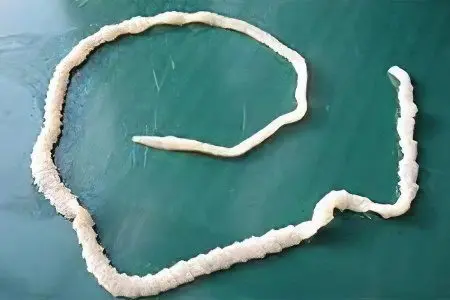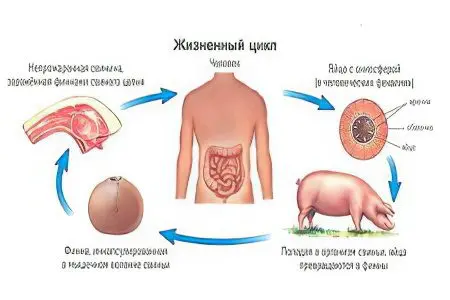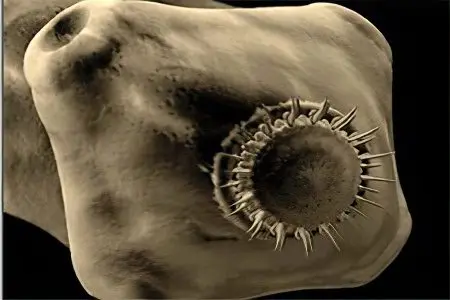Contents

The tapeworm is a tapeworm from the Taeniidae family. The parasitism of the tapeworm in the human body is called “taeniasis”. This parasitic invasion manifests itself in digestive disorders, as well as in neurological and other disorders. Teniasis is dangerous for its complications, in particular, cysticercosis of the brain and eyes.
Pork tapeworm is a parasite, which is also called “armed” because of the numerous sharp hooks on the head and body. The helminth has a very large size, it can reach 4 meters in length.
There are 4 suckers on the head of the pork tapeworm, and there can be from 22 to 32 hooks. Next is the neck, which passes into the segments. They have a quadrangular shape, their number can reach 1000 pieces. In its appearance, the pork tapeworm resembles a direct relative, the bull tapeworm, but is inferior to it in size.
The worm is a hermaphrodite, it fertilizes itself. Each fertilized segment can contain up to 50 thousand eggs. Inside the egg is an embryo called the oncosphere. To complete the development cycle, the oncosphere leaves the human intestine and settles in the body of the intermediate host (pig). After a certain time, the worm enters the human body again, and only there can it become a sexually mature individual. However, oncospheres are ready for invasion immediately after leaving the anus of a person, only it is possible to become infected with not teniasis, but cysticercosis. This disease is even more dangerous, as it is more difficult to treat.
The disease is widespread in Asian, African and Latin American countries. Although cases of taeniasis are recorded throughout the world, most of the cases are in those regions where pig production is well developed. Therefore, Russia, Ukraine, Belarus and the Baltic States are no exception. In global foci endemic for this parasitic invasion, the infection rate of pigs is up to 35%, so there are hundreds of thousands of sick people.
Symptoms of pork tapeworm

The symptoms of tapeworm in humans can look different. Sometimes they are completely absent, sometimes they appear, but weakly, and sometimes the clinical picture is quite pronounced.
The first signs of the disease manifest 1,5-2 months after ingestion of the larvae of the worm.
Symptoms of pork tapeworm in the body may be as follows:
Initially, nausea and vomiting occur, then the disorder of the stool joins. At the same time, pronounced diarrhea is replaced by persistent diarrhea.
Appetite of the person worsens, slow loss of weight begins.
There are pains of varying intensity in the abdomen, ranging from mild aching pains to severe cramping attacks.
Teniasis is characterized by anal itching.
Patients often complain of headaches, dizziness, increased irritability.
The patient’s sleep suffers. In the daytime, this is expressed in increased fatigue and fatigue.
Sometimes fainting is observed.
The patient develops iron deficiency anemia with symptoms characteristic of this condition.
The immune system suffers. The person becomes more susceptible to other diseases.
It should be noted separately infection with an extraintestinal form of teniosis – cysticercosis. So, during vomiting, segments of the parasite from the intestine can enter the human stomach. Any of them may contain invasive tapeworm eggs. In the stomach, the egg shell dissolves, and the larvae begin to migrate throughout the human body. They can settle on any internal organs and muscles. Thus, cysticercosis of the eyes, skin, brain, lungs or heart develops. Therefore, the symptoms of each disease should be considered separately.
Symptoms of pork tapeworm in the brain

It is the brain that is most often affected by cysticerci, if we consider the extraintestinal form of the disease (about 60% of all cases of extraintestinal invasion).
Cysticercosis of the cerebral hemispheres. Patients have cerebral hypertension and hydrocephalus if the cerebral hemispheres are affected. This is expressed in severe paroxysmal headaches, in frequent dizziness. Speech deviations, deterioration of sensitivity, epileptic seizures are not excluded. Separately, it should be noted mental abnormalities in such patients. They often suffer from depressive disorders, from hallucinations and delusions.
Cysticercosis of the ventricles of the brain. If the larvae of the worm penetrate the ventricles of the brain, then the patient develops very severe headache attacks, which are accompanied by vomiting. Symptoms worsen when turning the head. Doctors call these manifestations Bruns syndrome. In parallel, there may be a loss of consciousness and worsen the work of the heart.
Cysticercosis of the base of the brain. If tapeworm larvae begin to parasitize at the base of the brain, then the patient has symptoms of meningitis with headaches, vomiting, and damage to the cranial nerves.
Cysticercosis of the brain is a very dangerous form of the disease. It should be noted that damage to the cerebral hemispheres by tapeworm larvae is the leading cause of epilepsy in those countries where taeniasis is widespread.
Symptoms of tapeworm in the eye

Cysticercosis of the eye is manifested primarily by chronic inflammation of the organ of vision. Patients long and unsuccessfully treated for conjunctivitis, uveitis, retinitis. The larvae are capable of infecting the vitreous body, penetrating the conjunctiva, the retina and the anterior chamber of the eye. If there is no adequate treatment for a long time, then the development of complete blindness with atrophy of the eyeball is not excluded.
Symptoms of cysticercosis of the lungs are almost always absent, and the disease is detected by chance, during an X-ray examination.
If the larvae of the tapeworm settle in the heart, then this is manifested in cardiac arrhythmias.
The most favorable course of the disease in case of damage to the skin. It is usually possible to detect an invasion quickly, since a tumor appears in the place where the larva has stopped.
Ways of human infection with tapeworm

The mechanism of transmission of pork tapeworm is fecal-oral, while the route of human infection with pork tapeworm is food (less often, water).
Most often, the penetration of worm larvae into the gastrointestinal tract occurs as follows:
Eating raw or poorly cooked pork. Infection occurs when the meat contains cysticerci.
Human infection is possible when drinking water with tapeworm larvae.
Less often, the parasite enters the body of a person with unwashed hands.
The natural susceptibility of humans to disease is high. A person suffering from teniasis can infect himself and those around him with tapeworm larvae – cysticercosis of the muscles, brain, eyes, skin, heart.
Pork tapeworm is able to exist in the human body for several decades. The disease is common in settlements that are unfavorable in sanitary terms. Teniasis is more often recorded in adults than in children. At risk are employees of pig farms, meat processing enterprises, as well as housewives.
Why is pork tapeworm dangerous?

Pork tapeworm is dangerous to humans with the following consequences:
Inflammatory, mechanical and toxic effects of the worm on the body.
Consumption by the pork tapeworm of nutrients that were intended for humans.
The development of acute appendicitis with the penetration of the worm into the appendix.
Development of acute pancreatitis or cholangitis.
Sensitization of the human body by the products of decay and metabolism of the parasite with the subsequent development of toxic-allergic reactions.
The formation of intestinal obstruction in case of multiple invasion or in the event that the worm strays into a lump.
Cysticercosis of the brain, skeletal muscles, myocardium, lungs, liver, eyes, abdominal cavity, spinal cord.
Since the complications that this parasitic invasion can cause are quite serious, treatment should be as prompt as possible and begin immediately after the detection of tapeworm in the human body.
The life cycle of the development of pork tapeworm

The life cycle of the development of the pork tapeworm is quite complex and requires a change of two owners. The main host of the parasite is humans, and the intermediate host is pigs or wild boars.
Adult sexually mature specimens of the tapeworm parasitize in the human intestine, excreting segments together with feces, which contain invasive helminth eggs.
In the external environment, tapeworm larvae emerge from the segments. They enter the body of pigs while eating animal waste contaminated with oncospheres, or while drinking contaminated water.
After the larva enters the stomach of the animal, it is released from the shell and spreads throughout the body with the blood stream. The vast majority of the larvae settle in the muscles of the pig, where future parasites begin to mature. After 2-2,5 months, the oncospheres turn into cysticerci or into Finns (vesicles with larvae). Cysticerci remain viable in the pig body for 3-6 years, after which they calcify and die.
When a person eats meat with tapeworm larvae, parasitic infection occurs. After the bubble enters the small intestine, the head is released from it, which, with the help of suction cups and hooks, is attached to the intestinal wall and begins to grow. After 2 months, the parasite turns into a sexually mature helminth and begins to secrete segments with eggs into the external environment. This is how the life cycle of a pork tapeworm looks like.
Diagnostics

Diagnosis of pork tapeworm is built on the basis of three criteria:
In the feces of an infected person, segments of the worm are present.
There is a fact of eating pig meat, which was poorly processed thermally.
Data of laboratory diagnostics. First of all, several studies of feces and perianal scrapings are carried out. Macroscopic examination makes it possible to distinguish the segments of the porcine tapeworm from the segments of the bovine tapeworm. The former have 8-18 lateral branches, while the latter have 18-32 branches.
If the patient is diagnosed with teniasis, then he is shown an in-depth study. For this, the patient is sent for ophthalmoscopy, CT of the brain, x-ray of the lungs, ECG and other procedures to exclude cysticercosis of other organs.
Antibodies to porcine tapeworm can be detected using the following serological methods: ELISA, RNGA, RSK, NRIF.
Treatment
Treatment of teniasis is carried out exclusively in stationary conditions, since there is a risk of developing an extraintestinal infection. The patient takes medicines, from which the tapeworm begins to break into a rage. 2 hours after taking the drug, the patient is offered to take a saline laxative. This allows the segments of the worm to be brought out along with the eggs. It is important that the patient adheres to a dietary diet a few days before the start of therapy and throughout the course of treatment. Table number 13 is considered optimal for such a disease.
After performing anthelmintic therapy, at least 4 control studies of feces are carried out at intervals of 30 days.
If a patient has single cysticerci in the brain or in the eyes, then surgery is indicated along with etiotropic treatment.
If the patient has an intestinal form of the disease, then the prognosis is most often favorable. The same applies to the cutaneous form of cysticercosis. When it comes to damage to the brain and other internal organs, the prognosis depends on the massiveness of the invasion and on the specific location of the tapeworm larvae.
After completion of the course of treatment, the patient should be registered at the dispensary for another 2 years.









